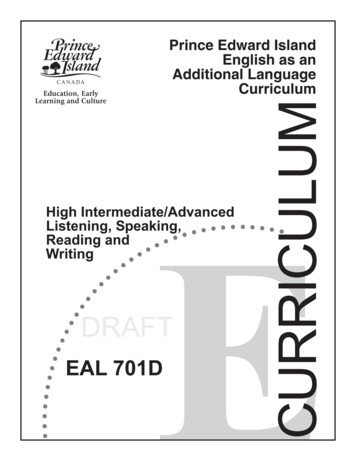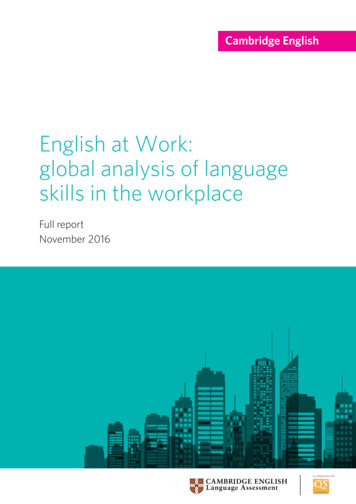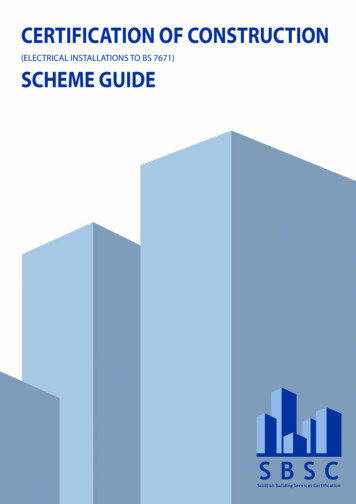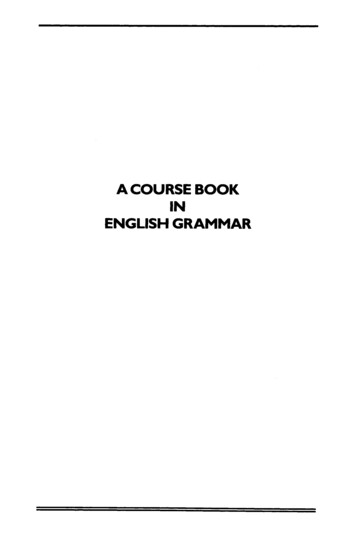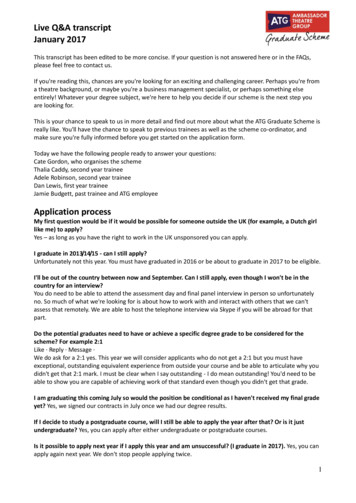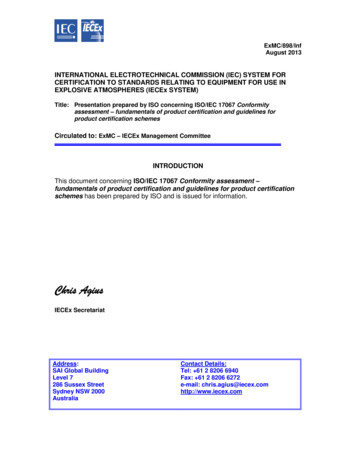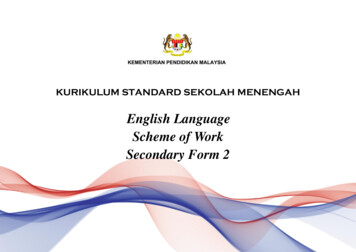
Transcription
KURIKULUM STANDARD SEKOLAH MENENGAHEnglish LanguageScheme of WorkSecondary Form 2
Secondary Form 2Scheme of WorkSecondary Form 2 Scheme of Work
ContentsContent Overview1. Content and organisation of the Scheme of Workp.52. Scheme of Work Template: supporting informationp.83. Glossary of terms in the Form 2 Curriculum Frameworkp.104. Differentiation strategies for secondary pupilsp.155. Scheme of Work: Lessons 1 – 112p.216. Appendicesp.137A. Textbook-Based Lessons: extension activitiesp.138B. Non-Textbook-Based Lessons: suggested activitiesp.158Secondary Form 2 Scheme of Work
Secondary Form 2 Scheme of WorkContent OverviewThe purpose of this document is to provide teachers with support and information with regards toplanning, creating and delivering their lessons throughout the year. Teachers will need to refer to thisdocument when planning and delivering their textbook-based lessons and creating their own nontextbook-based lessons.Contained within this Scheme of Work document, teachers will find the following information:1. Content and organisation of the Scheme of WorkThis section provides teachers with an introduction to the Scheme of Work and an explanation of howthe textbook-based lessons and the non-textbook-based lessons are organised within the Scheme ofWork.2. Scheme of Work Template: supporting InformationThis section provides teachers with an explanation of the various details contained within the Scheme ofWork template. This section also gives teachers advice on completing the Scheme of Work template fortheir own non-textbook-based lessons.3. Glossary of terms in the Form 2 Curriculum FrameworkTeachers will be required to create their own lesson plans and materials for the non-textbook-basedlessons. Teachers will therefore need to refer to the Content and Learning Standards contained withinthe Scheme of Work. These Content and Learning Standards come from the DSKP and the CurriculumFramework Document.This section provides teachers with supporting explanations for some of these Content and LearningStandards.4. Differentiation strategies for secondary pupilsThis section provides teachers with a number of suggested differentiation strategies which teachers maywish to use within their classes.5. Scheme of Work (Lessons 1 – 112)This section provides teachers with details for the textbook-based and non-textbook-based lessons.Secondary Form 2 Scheme of Work
6. AppendicesThe appendices contain additional support materials which it is hoped teachers will find useful. Thesematerials consist of the following:a. Textbook-Based Lessons: extension activitiesHere teachers will find a list of suggested activities which can be used to supplement/extend thelearning materials found within the Form 2 textbook. There are a number of activities for each unitof the textbook. In addition, the relevant Learning Standard is indicated along with the specificunit and page number of the textbook that each activity supports.b. Non-Textbook-Based Lessons: suggested activitiesFor those lessons where teachers will need to create their own lesson plans/learning materials,there are listed a number of suggested activities for each of the Form 2 Learning Standardsfound within the Curriculum Framework.Secondary Form 2 Scheme of Work
1. Content and organisation of the Scheme of WorkWhat is the Secondary Form 2 Scheme of Work and how can it help teachers?The Secondary Form 2 Scheme of Work gives teachers an overview of the Content and LearningStandards to be covered within each lesson. The Scheme of Work will provide teachers with assistancein their daily, weekly and longer-term planning of lessons.What does the Scheme of Work consist of?The Form 2 Scheme of Work consists of a total of 112 lessons with each lesson lasting a total of 60minutes. If lessons are organised into 30-minute lessons, teachers will need to plan and adapt theirlessons accordingly. Each lesson in the Scheme of Work is numbered from Lesson 1 to Lesson 112.The Scheme of Work consists of the following three types of lesson:1. Textbook-Based Lessons: The materials for these lessons will come from the selected Form 2textbook. This textbook is Pulse 2 and Form 2 will cover the content from Unit 6 to Unit 9 of thistextbook.2. Non-Textbook-Based Lessons: For this type of lesson, teachers will be responsible fordeveloping the lesson content and creating the necessary learning materials.3. Sample Lessons: At the beginning of the Scheme of Work teachers will find full lesson plans forLessons 1 – 6. The purpose of these sample lessons is to give teachers some initial assistanceas they start to work through the lessons within the Scheme of Work.5Secondary Form 2 Scheme of Work
How are the Scheme of Work lessons organised?As indicated above, apart from the initial Sample Lessons (Lessons 1 - 5), all the lessons from Lesson 6to Lesson 112 will be either a textbook-based lesson or a non-textbook-based lesson.1. Textbook-Based LessonsEach unit of Pulse 2 will provide teachers with materials sufficient for 11 lessons. This 11-lessoncycle will consist of the following:LessonLesson Skill/FocusTime1 LessonSpeaking60 minutes2 LessonsReading120 minutes1 LessonLanguage Awareness 160 minutes1 LessonListening60 minutes1 LessonEnrichment Activity60 minutes1 LessonLanguage Awareness 260 minutes2 LessonsAction-Oriented Task120 minutes1 LessonWriting60 minutes1 LessonLiterature in Action60 minutesTeachers are requested to note the following: The Reading and Action-Oriented Task lessons will cover a total of two lessons (i.e. 120minutes) due to the amount of material available for these lesson types in the Pulse 2textbook.Language Awareness Lessons will focus on a specific grammatical structure or function (e.g.learn and review difference between the use of the Present Perfect and Past Simple).Enrichment Activities are based on a reading text with a particular aspect of life in a differentEnglish-speaking country highlighted.Action-Oriented Tasks are integrated-skills-based lessons where all four skills are practisedand developed.Literature in Action: There are no specific materials in the textbook to support this lessontype. Therefore, teachers are encouraged to incorporate materials from the LiteratureComponent textbooks provided by the Ministry of Education. At the same time, teachers arealso encouraged to create their own lessons based on the themes and topics contained in therelevant textbook unit or by using other possible resources.It is strongly recommended that teachers follow the above structure in the order that it is presentedwithin the textbook as each section of a unit will follow logically and/or developmentally from theprevious section. For example, the Language Awareness grammar structures are often taken fromthe previous reading text. Therefore the structures are presented to pupils within an alreadyencountered context.The Form 2 Scheme of Work covers Units 6 – 9 from the textbook and therefore 44 out of the 112lessons will be textbook-based lessons.6Secondary Form 2 Scheme of Work
2. Non-Textbook-Based LessonsThese lessons will be developed by teachers either individually or by teachers working together topool their expertise and experience via the Professional Learning Communities (PLC) within theirschools.The non-textbook-based lessons consist of a 6-lesson cycle and are organised as follows:LessonLesson Skill/FocusTime1 LessonListening60 minutes1 LessonSpeaking60 minutes1 LessonReading60 minutes1 LessonWriting60 minutes1 LessonLiterature in Action60 minutes1 LessonLanguage Awareness60 minutesUnlike the textbook-based lessons, teachers can teach the above lessons in any order they wish. Forexample, the teacher may decide to teach the Language Awareness lesson immediately after aListening lesson and before a Writing lesson. The reason for this could be that the selected listeningtext contains specific examples of language structures that could then form the basis of theLanguage Awareness lesson. These structures could then be practised within the following Writinglesson. It is hoped that by not prescribing a specific order of non-textbook-based lessons, teacherswill have as much flexibility as possible for those lessons they will be creating themselves.It is important to note, however, that teachers are required to complete the full 6-lesson cycle beforemoving on to the next textbook-based or non-textbook-based lesson cycle.As teachers will observe below, the Scheme of Work is organised in that one textbook-based cycle(i.e. 11 lessons) is followed by three cycles of non-textbook-based lessons (i.e. 3 cycles of 6 lessons 18 lessons). This is to ensure that the textbook-based lessons are evenly distributed throughoutthe year.Teachers should note that the final two lessons in the Form 2 Scheme of Work (Lessons 111 and112) provide teachers with the opportunity to create project-based lessons. These can be based on adifferent project focus for each of the two lessons, or one project over the two lessons. Teachers willalso have the opportunity to select appropriate Content and Learning Standards for these twoproject-based lessons based on the specific needs and interests of their pupils.3. Sample LessonsTeachers will see that the lessons within the Scheme of Work begin with 6 sample lessons. Thesecover the first cycle of Speaking, Listening, Reading, Writing, Literature in Action and LanguageAwareness lessons. These are suggested lessons and teachers may wish to adapt the content ofthese lessons to ensure they are relevant for their own pupils.7Secondary Form 2 Scheme of Work
2. Scheme of Work Template: supporting Information1. LessonEach lesson within the Scheme of Work is given a number followed by the lesson type (e.g. Lesson 1Speaking, Lesson 2 Writing etc.). Where lessons cover two lessons in total (i.e. in the textbook-basedReading and Action-Oriented Task lessons) these are indicated by Lessons x – x (e.g. Lessons 7 – 8).2. Main Skill(s) FocusEach lesson will have one main skills focus with the exception of the Action-Oriented lessons which willhave a focus on all four skills (listening, speaking, reading and writing).3. ThemeThe four given themes are: People and CultureHealth and EnvironmentScience and TechnologyConsumerism and Financial AwarenessEach cycle of textbook-based lessons and non-textbook-based lessons has been assigned a specifictheme. This is to ensure that all of the above themes are adequately covered throughout the course ofForm 2.4. TopicTeachers will be responsible for selecting the specific topic areas for the non-textbook-based lessons.Teachers will need to ensure that the selected topic fits the given theme.5. Language/Grammar FocusThis will be related to either a grammatical structure/function (e.g. Present Simple and PresentContinuous) or an area of vocabulary (e.g. words related to free-time activities). Teachers are advised torefer to the syllabus for suggested grammar content for the non-textbook-based lessons.6. Content and Learning StandardsThe given Content and Learning Standards are taken from the DSKP and the Curriculum FrameworkDocument.7. Main Skill and Complementary Skill(s)Each lesson within the Scheme of Work will consist of one main skill and one complementary skill,though there are some lessons which contain two complementary skills. In order to ensure that pupilsreceive adequate exposure and practice to every Learning Standard within the Curriculum Framework, itis necessary to ensure that each Learning Standard appears at least 2 – 3 times within the Scheme ofWork. Sometimes this Learning Standard will appear as a main skill and sometimes as a complementaryskill. Therefore it is critical that teachers ensure that both the main skill and the complementary skill arecovered in each lesson. The complementary skill is not an optional skill that can be ignored or droppedfrom the lesson. Doing this may risk pupils not receiving adequate practice and exposure to all the givenLearning Standards within the Curriculum Framework. When teachers are planning their lessons they8Secondary Form 2 Scheme of Work
must therefore ensure that both the main skill and complementary skill are each assigned a suitablelearning outcome.Teachers should also be aware that the main skill and complementary skill should not be given equaltime and attention within the lesson. Teachers will need to ensure that the complementary skill iscovered, but the degree of attention the complementary skill receives in comparison to the main skill, willbe up to the teacher’s own professional judgement as they will know better the specific learning needs oftheir pupils.8. Learning Outlinea. Textbook-Based Lessons: Teachers will need to refer to the Teacher’s Book which providesdetailed information for teachers. This includes not only giving teachers guidance regardinglesson procedures for the main lesson content (Lesson Delivery), but also support with the givenlesson warmers/starters (Pre-Lesson), and end of lesson activities (Post Lesson).b. Non-Textbook-Based Lessons: As teachers will be responsible for creating their ownlessons, this section of the Scheme of Work has been left blank for teachers to completethemselves. However, teachers will need to refer to the given Content and Learning Standardwhen planning their lesson.9. Materials / ReferencesPage numbers from the Teacher’s Book have been given for the textbook-based lessons.For the non-textbook-based lessons, this section has been left blank for teachers to complete.10. Cross Curricular ElementTeachers will need to refer to the Cross Curricular Elements to complete this section of the Scheme ofWork for the non-textbook-based lessons. Suggested Cross Curricular Elements have been provided forthe textbook-based lessons.11. Differentiation StrategiesTeachers have been provided with a number of suggested differentiation strategies (see Section 4Differentiation strategies for secondary pupils). Teachers will need to select those strategies which aresuitable in relation to the materials used and the specific needs of their pupils.12. Teachers’ Notes / RemarksThis is has been left blank for teachers to complete as appropriate.9Secondary Form 2 Scheme of Work
3. Glossary of terms in the Form 2 Curriculum FrameworkEach lesson in the Scheme of Work contains specific Content and Learning Standards. Teachers may find useful the following explanations of some ofthe terms used.Term in Form 2 Curriculum FrameworkMeaningListeningListening 1.1.1Understand independently the main ideas insimple longer texts on a range of familiartopicsSee also Listening 1.1.2 Listening 1.1.3 Listening 1.2.1 Reading 3.1.1 Reading 3.1.2 Reading 3.1.3 Reading 3.1.4 Reading 3.1.5 Reading 3.2 Writing 4.2.3Understand independentlyPupils who can understand the main idea of a text independently can understand the mainidea without any help.simple longer textsSimple texts are texts in which content is organised clearly, and which contain language andideas which pupils can understand. Longer texts are usually more than 10 lines long.Teachers should use their own judgment on simple longer texts, based on the level andinterest of the pupils they teach.a range of familiar topicsA range of familiar topics means a variety of topics which pupils know. Examples includetopics covered in primary school such as clothes, free time, and animals, and in the Pulse 2textbook, such as jobs and chores, transport, and sport.However, pupils in rural or remote areas and pupils who live in cities may be familiar withdifferent topics. Teachers should use their own judgment here.10Secondary Form 2 Scheme of Work
Listening 1.1.3Recognise with support attitudes or opinions insimple longer texts on a range of familiar topicswith supportwith support means with help. This help can come from the teacher, a classmate, frompictures, examples or explanations in their textbook or from a reference resource, such as adictionary.See also Reading 3.1.5Listening 1.1.4Understand with little or no support longersequences of classroom instructionsSee also Listening 1.1.2 Listening 1.1.5 Listening 1.1.6little or no supportLittle support means that pupils may sometimes need a small amount of help to understandmain ideas. No support means that they can understand main ideas without any help.If pupils need help, this can come from the teacher, from classmates, from pictures,examples or explanations in their textbook or from a reference resource, such as adictionary.longer sequences of classroom instructionsLonger sequences of classroom instructions usually contain 3 sequences or more in thetask which pupils do (e.g. First, match the sentences and pictures, then underline the falsesentence, explain to your partner why it is wrong, and then write the true sentencetogether.’)Teachers should use their own judgment on longer sequences of supported classroominstructions based on the language level and background knowledge of the pupils theyteach.Listening1.1.5Understand with little or no support morecomplex questionsmore complex questionsA more complex question is a question which contains more than one clause (e.g. Wheredid they go on holiday and why did they enjoy it?)11Secondary Form 2 Scheme of Work
Listening 1.1.6Understand with little or no support longersimple narratives on a wide range of familiartopicslonger simple narrativesLonger simple narratives are stories which are usually longer than 10 lines. The simplenarratives contain language and ideas which pupils can understand.Teachers should use their own judgment on longer simple narratives, based on the leveland interest of the pupils they teach.a wide range of familiar topicsA wide range of familiar topics means almost all of the topics which pupils know. Examplesinclude the topics which pupils have studied in English in primary school, such as clothes,free time, and animals, and in the Pulse 2 textbook, such as jobs and chores, transport, andsport.However, pupils in rural or remote areas and pupils who live in cities may be familiar withdifferent topics. Teachers should use their own judgment here.12Secondary Form 2 Scheme of Work
SpeakingSpeaking 2.1.2Ask for and respond appropriately to simplesuggestionssimple suggestionsSimple suggestions are suggestions which are contain ideas and language which pupils canunderstand e.g. Let’s ask Anita to help us.Ask for and respond appropriatelyPupils who can ask for suggestions and respond appropriately can ask for a suggestions(e.g. What should we do?) and can respond by accepting or rejecting a suggestion e.g.Good idea! / Thanks, but I’ve done that already)Speaking Content Standard 2.3 FocusManage interaction appropriatelyappropriatelyAppropriately refers to the successful communication of a message. The message itselfmay not necessarily be 100% accurate, but the pupil has communicated his or her meaningsuccessfully.See also Speaking 2.3 Writing 4.2 Writing 4.2.3Speaking 2.3.1Keep interaction going in longer exchanges bychecking understanding of what a speaker issayinglonger exchangesLonger exchanges are usually interactions in which each pupil has more than 4 speakingturns.13Secondary Form 2 Scheme of Work
WritingWriting 4.2.1Punctuate written work with moderateaccuracywith moderate accuracyModerate accuracy means that punctuation is mostly accurate, but written work sometimescontains mistakes. Such mistakes are typical of A2 learners.See also Writing 4.2.2Writing 4.2.3Produce a plan or draft of two paragraphs ormore and modify this appropriately either inresponse to feedback or independentlymodify this appropriately in response to feedbackFeedback means comments on a pupil’s piece of written work from the teacher or fromother pupilsPupils who can modify a draft appropriately in response to feedback can use the commentsthey receive to reorganise content and correct most language errors. The result is a seconddraft which is easier to understand and which contains fewer language errors than the firstdraft.14Secondary Form 2 Scheme of Work
4. Differentiation strategies for secondary pupilsStrategy 1: Differentiate by instruction and feedbackUse classroom management techniques to support differentiation.1. Ensure that pupils who are finding particular tasks in English challenging still have a chanceto contribute in class in order to develop their confidence. You can do this in a number ofways. The following are a few examples:i) Ask them to read instructions aloud.ii) Monitor and check that pupils having difficulty with the task have completed the firstfew questions correctly and when going through feedback with the whole class,choose them to answer the first one or two questions which you know they have donecorrectly.iii) Prompt and support during group work if a pupil is having difficulty with the task orwith confidence, then indicate and praise them when they have done well. When youcheck answers with the whole group you will then ask them to do the question youhave just seen them answer.iv) Choose them to be ‘group leaders’ for games or activities, e.g. count the points forteam games, ensuring the group completes the work.v) Choose them to ‘report back’ after group work – this means they will repeat what thegroup has done even if they didn’t come up with ideas themselves.vi) Ask them to take responsibility for classroom tasks, e.g. helping hand out copies sothey are involved even if they are struggling with questions.vii) Ask them to write answers up on the board while other pupils call out the answers.2. Before checking answers with the whole group, always allow pupils to do a peer check(comparing their answers in pairs or small groups). This encourages confidence as there is ashared responsibility for any errors. It also allows peer to peer teaching – some pupils canclarify and those struggling with the tasks will gain extra support.3. When getting feedback, don’t go around the class picking pupils in order. Ask pupils randomly(making a note if it helps to ensure you ask different pupils each time over a few lessons).Choose the respondent according to the level of the task and what you know about yourpupils.4. Monitor closely – this will allow you to check that everyone has understood and is doing thetask successfully and to provide extension questions to those finding the task easy.5. Always do an example for each task. This provides a clear instruction for everybody. Thosefinding the task easy can help supply the example to increase the challenge.15Secondary Form 2 Scheme of Work
Strategy 2: Differentiate by the task pupils are givenIt is possible to use the same source material and expected outcomes but to adapt and differentiate theway the task works for pupils. This takes slightly more preparation for the teacher but the tasks can oftenbe reused for more than one class.Examples of task differentiation (all taken from Pulse 2 pages 33 - 35) include the following:i)Give more proficient pupils standard ‘gap fill’ tasks but add in multiple choice options for the lessproficient pupils. For example: We’re having lots of adventures on our holiday. While we 1. (stay) at a campsite near ariver, we 2. (have) a terrible experience. We’re having lots of adventures on our holiday. While we 1. stayed/were staying at a campsitenear a river, we 2. had/were having a terrible experience.ii) Give more proficient pupils sentence constructions e.g. requiring them to add in correct tenses,but change the task to ‘tick the correct sentence’ or ‘use the tense given’ for less proficient pupils.For example: Make sentences using the past continuous and past simple:His brother/eat/when/the lights/go out. Tick the correct sentence in each casea. His brother ate when the lights went out.b. His brother was eating when the lights were going out.c. His brother was eating when the lights went out.iii) For exercises involving filling in a table or categorising (see Pulse 2 page 32, exercise 6) addsome items into the table in advance for less proficient pupils but leave more proficient pupils todo all the items themselves and even add some additional ones of their own.iv) For grammar analysis boxes where the use of a grammar form has to be completed or matchedto a reason (see Pulse 2 page 35, exercise 1), give the correct answers to less proficient pupilsand add examples that they match to the analysis. The more proficient pupils can complete thetask as given in the textbook.v) For standard question / answer formats, allow more proficient pupils to answer unsupported. Givethe answers to less proficient pupils but mix them up so it becomes a matching task.Sometimes, the teacher can also give different tasks to more proficient and less proficient groups ofpupils according to their needs and interests: see strategy 6 for more on this.Another way to differentiate by task, if using the same task for the whole class, is to include some openended items which allow for a large number of correct responses. This can vary in terms of the amountpupils produce or the complexity of their answers.16Secondary Form 2 Scheme of Work
Tasks might include:i) brainstorming listsii) creating mind mapsiii) thinking of examplesiv) playing games requiring personalised answers, e.g. about their hobbies / likes and dislikes /familiesv) doing a presentation of informationOpen-ended discussion tasks (e.g. Tell me about life in cities and life in the country, or What willhappen next?) allow more proficient pupils to contribute with more unusual words, more complexlanguage, or more original ideas.Project work is particularly good for differentiating tasks. You can give slightly different tasks to less andmore proficient pupils, e.g. a stronger group may be asked to create a booklet and presentation onhistorical places in Malaysia; less proficient pupils might be asked to create the same for one historicalplace. (See also additional ideas in Strategy 4).Strategy 3: Differentiate by the type and amount of support providedThe teacher can support pupils to understand and use language with:i) their own teacher talk (e.g. ‘Look at the words in the box. Which one is a number?’)ii) with gestures or mimeiii) utilising more proficient pupils to reinforce, e.g. the teacher sets an instruction or clarifies anew word - to check the instruction or reinforce the word, choose a more proficient pupil torepeat or explain again. This will encourage more proficient pupils to produce language andadd challenge for them and the repetition will also support less proficient pupils.iv) with visuals (e.g. flashcards on the board to help pupils understand or use vocabulary),v) with written words (e.g. written words on a worksheet to help pupils with spelling)vi) when giving tasks, have two worksheets – add in a gloss (clarification) of important and/ordifficult vocabulary in basic English or mother tongue.vii) where pupils are doing project work, encourage more proficient pupils to do more, e.g.research content themselves and support less proficient pupils with input e.g. give themhandouts of information to start using rather than expect them to find this themselves.Different types and amount of support can be given to less proficient pupils, depending on theirneeds, or can be used to provide extra challenge for more proficient pupils.17Secondary Form 2 Scheme of Work
Strategy 4: Differentiate by the outcome expected from pupilsThe teacher may expect more language from some pupils, and less from others. The main aim is thatevery pupil says or writes something, so that they feel successful. Four useful strategies here are: Compulsory plus optionalRemember and shareAdd onProject worki)Compulsory plus optionalHere, the teacher sets pupils targets such as With your partner, write 2 sentences or more, or Inyour group use two new words. The minimum target (2 sentences, 2 new words) is compulsory,and everyone needs to achieve this to be successful. But the ‘or more’ is optional, and gives achance for more proficient pupils to challenge themselves. Some pupils will stop at the minimumtarget at first, but with more practice, they will soon get the idea of going beyond the minimumtarget. This can be simple, e.g. ‘There are 10 true and false questions for the reading. You have5 minutes. You must do 5 questions – you can choose any 5. If you have time you can do more.’This will allow pupils to do more or less and also to choose the questions they find easiest.ii)Remember and shareIf pupils are asked to remember and share, they have to tell the teacher words or ideas theylearned in a previous lesson or task. (E.g. Look at the classroom objects on my table. In oneminute, I’ll cover them Now, share with your group what you remember and then tell me). Thistask allows all pupils to make successful contributions.iii)Add onMonitor during tasks, e.g. reading or listening questions. Where pupils have done well, have afew extension questions to hand and ask them. Alternatively ask them to rewrite sentences orthink of their own additional questions to ask other more proficient pupils.iv)Project outcomeIf pupils are doing project work, encourage more proficient pupils to do more – either produce agreater quantity of output or produce more complex outcomes. For example, if pupils are doing aproject on the environment, more proficient pupils can research and produce a written report anddo a class presentation; less proficient pupils can be given materials to use for ideas and producea short illustrated summary only.18Secondary Form 2 Scheme of Work
Strategy 5: Differentiate by the time pupils are given to complete a task.Some pupils need longer than others to complete tasks, especially when writing is involved. When it’sappropriate, these pupils should be given a little more time to finish, and extra tasks for pupils whocomplete the task early should be provided (e.g. Write three more sentences using the
Textbook-Based Lessons: The materials for these lessons will come from the selected Form 2 textbook. This textbook is Pulse 2 and Form 2 will cover the content from Unit 6 to Unit 9 of this textbook. 2. Non-




